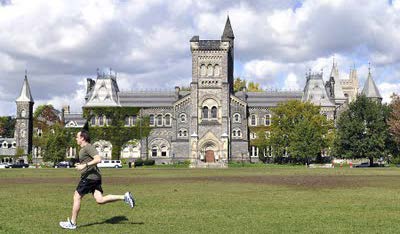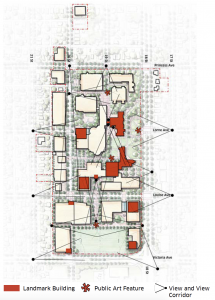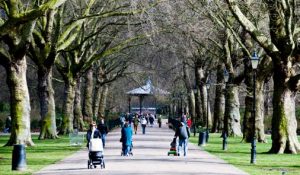Views, View Corridors, & Landmark Sites

Defined views and view corridors, and the integration of landmark building structures, landscaping, and art assists in campus wayfinding and building identity for the University. It also helps to create visual interest, and to visually link spaces. Having clear views through the campus supports the development of a safe environment. Pedestrians are able to see clear routes through the campus and easily identify where they are going.
Views and view corridors should also be experienced from within as an opportunity to experience the campus spaces, understand the layout of the Campus and its connections beyond. Tall buildings provide opportunities to experience views through the Campus, to the neighbourhood, and to the city, and should be located accordingly.
Creating view corridors through and to the Campus provides opportunities to showcase unique architecture. Defined views to significant buildings enables the recognition and appreciation of prominent landmarks and architecture, new and old. Having landmark buildings as a terminus to views further enables wayfinding as it allows pedestrians to locate themselves throughout the Campus.
Locating significant buildings or distinct architectural form at entry points or along the Campus’ periphery is a way in which to draw people into the campus as they approach the campus from a distance, or as they are at the Campus’ edges.
Policies:
- The structure and placement of buildings and landscape should be designed to enhance existing views or establish new views throughout the Campus.
- There should be clear and unobstructed views at all points of access into the Campus.
- Views into the Campus at all gateway entrances should be terminated with or have a prominent landmark feature as a draw into the Campus, such as a building tower, a glassed atrium frontage, distinct tree planting, and a significant art piece.
-
Larger and more prominent features should be used to terminate long views into the Campus so that they can be seen from afar.
- There should be clear and unobstructed views along the north-south and east-west spines – Louise Avenue, 20th Street, the north-south spine, and the central east-west pedestrian plaza.
- The design of new buildings, or the retrofitting of existing buildings, should include public spaces in which to experience and appreciate views to adjacent open spaces within the Campus.
- There design of new tall buildings, or the retrofitting of existing tall buildings, should include public spaces in which to experience and appreciate views through the Campus and beyond as an opportunity to visually connect to the community and city context.
- Landmark buildings, especially at the Campus’ periphery, should be designed to be welcoming, transparent, animated, and representative of the character and quality of place.
- Design landmark buildings intended to terminate or define view corridors, or to define gateways, as opportunities to showcase pedagogical uses and activity and draw people into the Campus.


